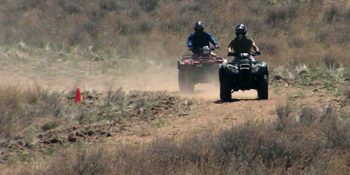DENVER – At its virtual meeting on May 6, the Colorado Parks and Wildlife Commission unanimously approved the 2020 – 2021 OHV Trail Grant funding award recommendations for $4.273 million to fund 60 trail projects across Colorado representing 4,320 trail work days across Colorado.
Money from Colorado OHV registrations accounts for $4 million of the funds, while the Recreational Trails Program is providing the remaining $273,000.
“This is literally OHV dollars going right back into the trails,” said CPW State Trails Program Manager Fletcher Jacobs. “This year we funded 36 maintenance trail crews across the state crews, 24 of which are Good Management crews, which allow our federal partners at the United State Forest Service and Bureau of Land Management to get much needed consistent funding for trail crews.”
Some of the highlights from this year’s grant award winners include:
USFS – Dolores Ranger District: $72,000
The Dolores Ranger District and a Southwest Conservation Corps (SCC) crew will work in partnership on trail maintenance projects on the East Fork trail. The SCC crew will focus on over 6.5 miles of the East Fork trail that is in need of heavy maintenance. Work will be done on sections of the trail that require extensive drainage and tread rehabilitation. Switchbacks will be improved by utilizing climbing turns and other drainage features.
Grizzly Peak/Timberline Trail Reconstruction – 2021
USFS – Gunnison Ranger District: $64,700
This project will provide trail relocation work, heavy reconstruction, trail restoration and heavy trail maintenance to a section of the Timberline Trail #414. The primary focus will be trail reconstruction of existing trail and realignment of unsustainable trail. It is estimated that about 3 to 4 miles of trail will be reconstructed southeast of the Pieplant access point, nearly ¾ of a mile of new trail will be constructed, and approximately 2,500 lineal feet of abandoned trail will be restored. Specifically, the work will include realignments of steep trail sections, tread reconstruction, switchback construction/reconstruction, drainage installation/repair, and trail armoring techniques where needed. Restoration of abandoned trail sections, non-system routes, and trail braiding areas will be restored using log or rock check dams and trench backfill techniques. The work will be done by Forest Service personnel and volunteers and will meet or exceed Forest Service trail specifications. The primary goal of this project is to improve user experiences, create more sustainable trails, improve user safety, and to protect natural resources.
CPRD OHV Trailhead Improvement Project
USFS – Conejos Peak Ranger District: $111,255
The district’s Recreation crew along with a Southwest Conservation Crew (SCC) will work together to improve the trailheads of all of the District’s single track motorized trails. Work to be done will include: installing restrictor gates, trailhead signs, and interpretive travel management signs on travel management signs at 12 trailheads. Users will be educated on the proper use of the trails and regulations enforced by placing the needed signs and barriers at the trailheads.
A complete list of the 2020 – 2021 OHV Trail Grants is available here.
About the grant process
The Colorado State Trails Committee is responsible for the review process for the trail grant applications and makes recommendations to the Colorado Parks and Wildlife Commission regarding funding for grants.
The OHV/motorized trail grant selection process follows a four-tiered review and approval protocol. All grant applications are first reviewed by CPW wildlife field biologists and regional CPW staff. This process allows CPW to flag potential wildlife issues prior to the review by the subcommittees. While concerns may be flagged during this review, CPW’s field staff attempts to resolve these concerns prior to the subcommittee’s review. Next, applications are evaluated by the OHV Grant Review and Ranking Subcommittee to score and rank the OHV competitive grant applications in order of their recommended funding priority. The ranked applications are then passed to the Committee to evaluate the applications in ranked order and recommend funding strategies to the Commission. The Commission provides the final approval to the funded projects. This process invites public review and comment at four separate stages: upon submission, before the subcommittees, before the State Trails Committee and before the Commission.
SPREAD THE NEWS
COMMENT, Like, Follow & SHARE @I70Scout
CURRENT EDITION
WEATHER & TRAFFIC PUZZLES RECENT NEWS ADVERTISE WITH US

Leave a Reply